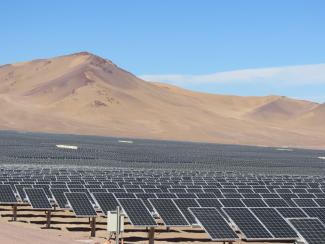Chile
An energy transformation without subsidies

Fifteen years ago, Chile’s electricity generation depended largely on gas imports from Argentina. Those imports came to a halt in 2007 as a direct result of the energy crisis in Argentina. In order to secure its electricity supply – in particular that of the copper mining industry in northern Chile – the country installed first diesel power plants, which were then slowly replaced by less expensive coal-fired power plants.
The use of renewable energy was not a priority at the time. Nevertheless, Chile’s Atacama Desert has the highest solar irradiation in the world, and the south of the country also has ideal locations for power generation by wind energy. Lack of information and mistrust of new technologies characterised the energy market, however. The situation changed thanks to continuous contributions by GIZ, which works as adviser for Chile’s energy transformation on behalf of Germany’s Federal Ministry for the Environment. A detailed analysis of Chile’s renewable energy potential provided the necessary planning security to expand the industry. According to the analysis, Chile has a realistic potential of over 1,865 gigawatts (GW) capacity from wind, solar and small hydropower. That is about 75 times the current installed electricity generation capacity of around 25 GW.
Thanks to numerous discussions with experts and an intensive exchange with German electricity-grid operators, Chilean grid operators and other important actors in the energy sector overcame their initial scepticism and became enthusiastic advocates of renewables. As a result, and not least due to falling technology prices, Chile has recorded the world’s largest percentage expansion of renewable energies in the electricity sector in the years 2015 to 2018 – without government subsidies. Currently around a fifth of the country’s electricity comes from fluctuating renewable sources (solar, wind, small hydropower); if large hydropower is included, the total comes to 45 %.
Green hydrogen
The next step was to make sectors other than electricity sustainable as well. Since 2015, there has been activity in the area of green hydrogen, which is created using electrolysis from renewable electricity. Today it is almost profitable in Chile. Therefore, hydrogen can contribute to reducing greenhouse-gas emissions in the energy sector, industry and transport, and help the country to become climate neutral by 2050. Furthermore, green hydrogen could become a new major export item for Chile, alongside copper. GIZ is currently supporting the Chilean government in creating a national hydrogen strategy, which should be completed by the end of 2020. Germany also presented a national hydrogen strategy this year and can consider Chile, along with African countries like Morocco, as a supplier of green hydrogen or its derivatives.
Another exciting development is Chile’s incremental phase-out of electricity generation by coal, which is happening parallel to its expansion of renewables and in close cooperation with the industry. Almost two-thirds of coal-burning power plants with a total capacity of 5,529 megawatts have only been in operation for less than ten years. Nevertheless, the power-plant operators have, without state subsidies, voluntarily committed to ending coal-fired generation by 2040.
Together with the German Aerospace Centre (DLR) and two coal-fired power plant operators, GIZ is now analysing whether the coal plants that will be decommissioned can be converted to thermal energy storage for solar and wind energy. That way the majority of existing infrastructure could still be utilised and the shutdown of the power plants could be accelerated. Chile’s experiences in phasing out coal could be useful for many other countries, and the energy transformation that has been carried out in the South American country with Germany’s help is also a good example of successful international cooperation.
Rainer Schröer is the director of GIZ’s renewable energy and energy efficiency programme in Chile.
rainer.schroeer@giz.de







